There are seventeen lizards you may come across in South Carolina. These lizards are either native to the area or have been introduced and can range from small to larger lizards that may attract the attention of your child or pet.
Maybe you’re wondering what lizard your cat brought into the home or what lizard your child just captured and wants to keep as a pet.
Here is everything you need to know about the seventeen lizards you may see when living or visiting South Carolina.
Are There Poisonous Lizards In South Carolina?
The great news is that none of the lizards you come across in South Carolina are poisonous, but it’s important to know that they do carry disease.
If you touch or handle one of the lizards you come across, ensure you wash your hands thoroughly. The lizards are not poisonous to your dog or cat.
Lizards In South Carolina
There is such a variety of lizards you may see when exploring South Carolina, these include:
1. Green Anole

Scientific name: Anolis carolinensis.
Common name: Green anole, Carolina anole, Carolina green anole, American anole, American green anole, North American green anole, red-throated anole, American chameleon.
The green anole can be brown or green, depending on the environment.
They grow up to 8 inches (20cm) in length and sometimes have some markings on their back, especially those that are browner in color.
You can identify the males with their pin throats (dewlaps), often displayed when defending their territory.
These lizards can be found throughout South Carolina and Georgia, they prefer living in trees and can be found in urban and suburban areas, often seen on the roof or on top of a fence, basking in the sun.
These lizards are active by day when the weather is warm and can often be seen soaking up the sun. When the weather cools, you can find them under shingles, tree bark, and logs.
2. Brown Anole

Scientific name: Anolis Sagrei.
Common name: Brown anole lizard, Cuban brown anole, De la Sagra’s anole.
The brown anole can be brown or gray in color and grows up to 8.5 inches (21cm).
You can often identify them due to the yellow to white patterns on their backs. Males have a red to orange dewlap with white edging.
The brown anole was introduced from the Caribbean many years ago and is expanding throughout the United States.
The brown anole tends to spend more time in trees than the green anole, you can find them in urban and suburban areas.
They are very active during the day and you often see them basking in the sun during the summer months and hiding during the winter months.
3. Eastern Fence Lizard
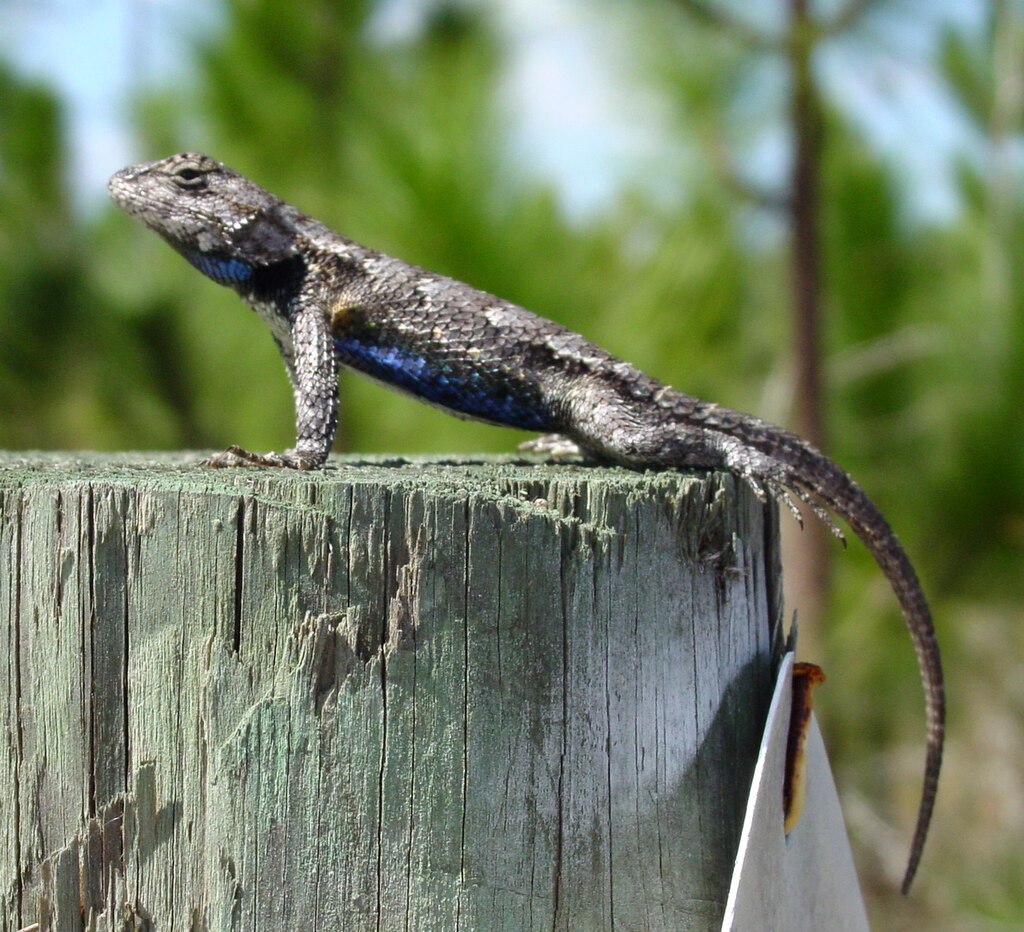
Scientific name: Sceloporus Undulatus.
Common name: Eastern fence lizard, prairie lizard, fence swift, gray lizard, northern fence lizard, pine lizard.
The Eastern fence lizard (Sceloporus Undulatus) is part of the spiny lizard family, which is native to South Carolina.
These lizards grow up to 7.25 inches (18.5cm) and are often gray in color, but they can range from brown to black.
Females tend to have patterns on their backs and males have bright blue patches under their tummy and chins during mating season.
These lizards can be found in a host of habitats such as open forests where there are lots of logs providing adequate hiding spaces.
The Eastern fence lizards are mostly tree-dwelling, though you can find them basking on the top of your fence on a hot summer day. They will run for the nearest tree if you approach them.
4. Texas Horned Lizard

Scientific name: Phrynosoma Cornutum.
Common name: Texas horned lizard.
The Texas horned lizards (Phrynosoma Cornutum) are small lizards with flat bodies, giving them a circular shape, which is why they are often referred to as horny toads.
These lizards grow up to 4 inches (10cm).
They have a row of large scales around their heads, which look like horns. They tend to be brown to sand in color with dark spots, which helps them blend seamlessly into their environment.
The Texas horned lizards were once common pets and therefore have been introduced throughout the Southeast United States with the most established populations being in South Carolina and Georgia.
You often find these lizards in sandy habitats, that are warm. They are excellent in camouflaging themselves and may even partly bury themselves in the hot sand.
5. Six-Lined Racerunner

Scientific name: Aspidoscelis Sexlineatus.
Common name: Six-lined racerunner.
The six-lined racerunner (Aspidoscelis sexlineata) has is light yellow to white stripes down its back and grows up to 9.5 inches (24cm).
These lizards are ground-dwelling and can run at amazing speeds when approached or feel under threat.
These lizards are very common in South Carolina, where they prefer open fields, woodland edges, and sand dunes.
These lizards are very active, even on the hottest summer day. They hide in burrows when the weather cools or during nighttime hours.
6. Coal Skink
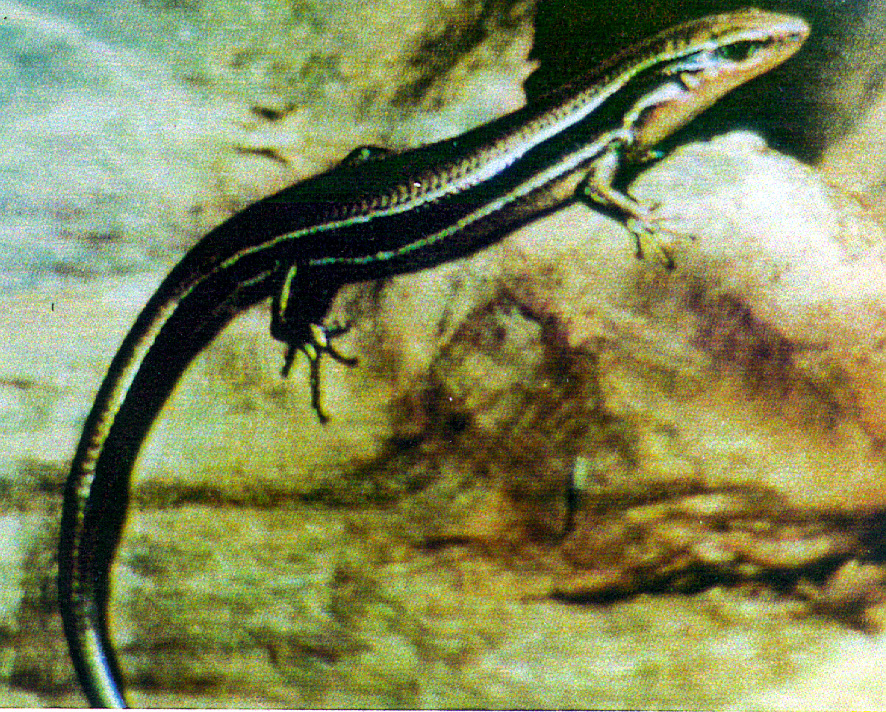
Scientific name: Plestiodon Anthracinus.
Common name: Coal skink.
The coal skink (Plestiodon Anthracinus) grows up to seven inches (18cm) and is a medium-sized lizard found in South Carolina.
These lizards have streamlined bodies with short legs.
The bodies tend to be brown or gray in color with four white to yellow stripes, two on either side. You can easily identify this skink from the other skinks, as it doesn’t have a single stripe down the back.

Coal skink distribution
They can be found in mountain areas, moist forests where there is plenty of rocks, logs, and leaf litter where they can hide. They prefer to be near a permanent water source and they will shelter in the water, hiding beneath the rocks.
They also break off their tails as a defensive measure, which can give them time to escape any predators.
7. Five-lined Skink

Scientific name: Plestiodon fasciatus.
Common name: American five-lined skink, five-lined skink.
Five-lined skinks (Plestiodon fasciatus) are large lizards with streamlined bodies and short legs.
These skinks grow up to 8.5 inches (21.5cm) and are usually brown, black, or gray with the background color.
The five-lined skink has five white or yellow stripes, two on either side and one down their back. Juveniles boast a bright blue tail, which will fade as they age. Male’s stripes may fade, as they develop a red to orange coloration on their heads.

8. Southeastern Five-Lined Skink

Scientific name: Plestiodon Inexpectatus.
Common name: Southeastern five-lined skink.
The southeastern five-lined skink (Plestiodon Inexpectatus) is what you will find in South Carolina.
They are ground-dwelling, though they do spend time in trees. You find them in wooded habitats which are dry. They prefer areas with ample fallen trees, so they can hide in and under the logs.

If pursued, the five-lined skink will run for the nearest tree bark to hide under. They can also break their tails in order to escape from predators.
9. Broadhead Skink

Scientific name: Plestiodon laticeps.
Common name: Broad-headed skink, broadhead skink.
Broadheaded skinks (Plestiodon Laticeps) are the largest skink you will find in the south east, except for glass lizards.
They can grow up to thirteen inches (33cm) in length with streamlined bodies and very short legs.
They are black, brown, or gray in color, though they do have a background color, along with five yellow or white stripes, two down either side and one down the center of their back.
Most adult’s coloration will fade over time and they become brown or gray, though the males will develop an orange head. Young broadhead skinks have bright blue tails and their stripes are very noticeable, this fades with age.

These lizards are common in South Carolina, living in wooded areas, where they bask in the sun on the branches or on the ground.
While the broadhead skink can be found in the trees and on the grounds, the larger males tend to become more tree-dwelling, when compared to the other skinks you can find in South Carolina.
These skinks will run for the nearest tree if they are approached and they will drop their tails as a way to distract their predator, giving them time to escape.
10. Mole Skink
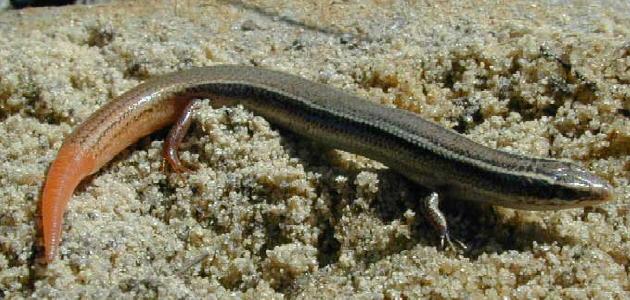
Scientific name: Plestiodon Egregius.
Common name: Mole skink.
Mole skinks (Plestiodon Egregius) are small lizards that have short legs with long tails. Their background color is brown to gray with two light stripes on either side of their bodies.
They also have an orange or red tail, which remains with them into adulthood. The red tail is what makes it so easy to identify these skinks from the others in the area.

The mole skink loves sandy, hot and dry areas and can be found under logs or boards or hidden in leaf litter. These skinks very rarely climb, they will run on the sand to escape.
They do break their tails to escape predators. They are very secretive in nature and not often seen.
11. Ground Skink

Scientific name: Scincella lateralis.
Common name: Little brown skink, ground skink.
Ground skinks (Scincella lateralis) are small lizards that run on their short legs. They have long tails with slender bodies, growing up to 5.5 inches (14.5cm).
These skinks can be light/golden brown to black in color, they have a dark stripe that runs down their body, one on either side. They have a yellow to white tummy.

These lizards can be found throughout South Carolina, except in the wetter areas. They prefer loose soil and plenty of leaf litter. You will find these little skinks under logs and other objects.
They are not big climbers and spend their time on the ground. They tend to “swim” through the leaf litter or soil and tend to disappear very quickly if approached.
They also will break off their tails to escape any predators when they feel threatened.
12. Mediterranean Gecko

Scientific name: Hemidactylus Turcicus.
Common name: Mediterranean house gecko.
The Mediterranean gecko (Hemidactylus Turcicus) comes from Northern Africa and Southern Europe and has been introduced to the Southeastern United States over the years.
These lizards grow up to five inches (13cm) and they have toe pads, which are sticky, allowing them to climb vertical surfaces. Their large eyes don’t have eyelids. They are light gray to white with some darker markings on the body, which has bumpy skin.
The Mediterranean gecko is nocturnal, moving around at night. They can be found in just about any area, though they are often found close to properties with night lights, where they feed on the insects attracted to the light.
During the day, they hide in crevices, under bark, and in cracks.
13. Indo-Pacific Gecko
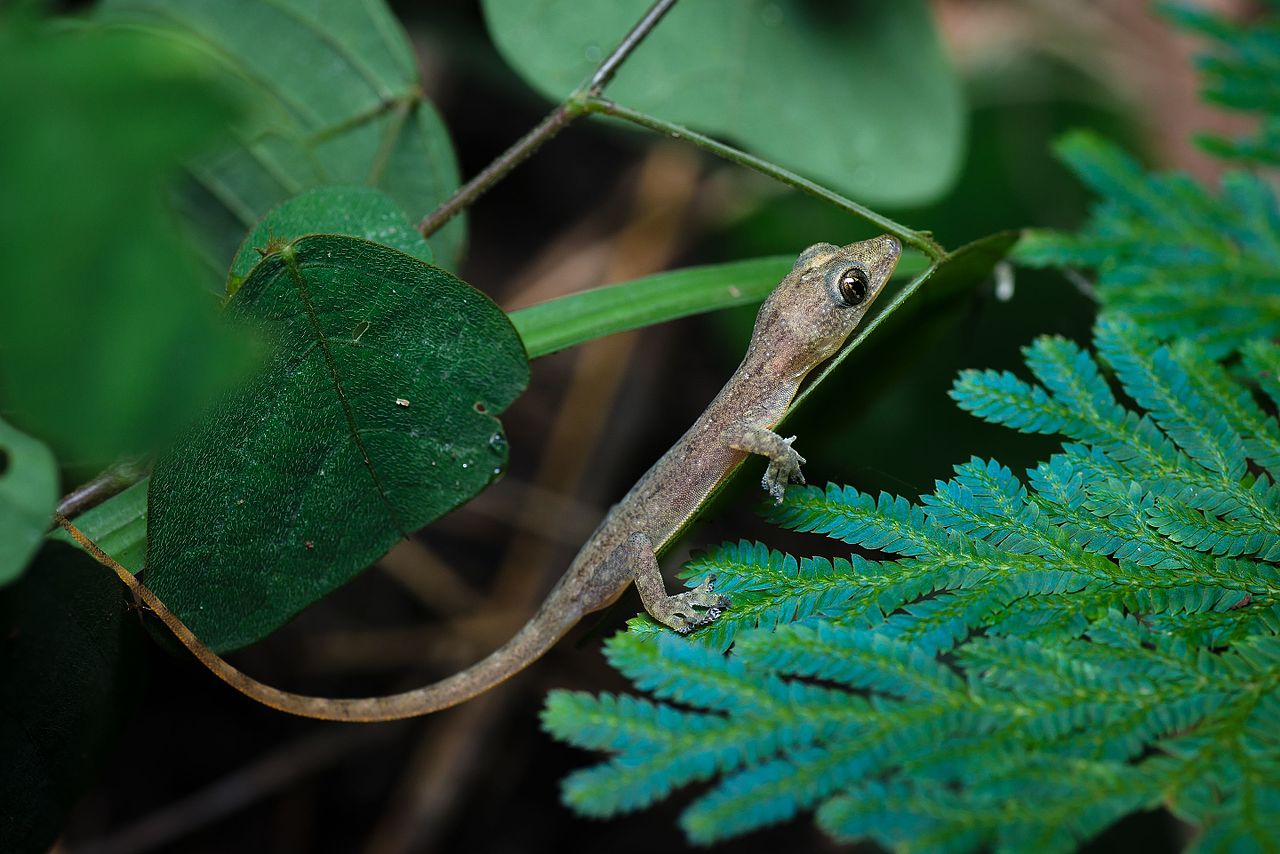
Scientific name: Hemidactylus Garnotii.
Common name: Indo-Pacific gecko, Garnot’s house gecko, fox gecko, Assam greyish brown gecko.
The Indo Pacific gecko (Hemidactylus Garnotii) is gray to brown in color and they have large eyes with smooth matt skin.
They grow up to 5.5 inches (13.5cm) and also have sticky toe pads, which help them climb vertical surfaces.
You can tell this gecko apart from the Mediterranean gecko by the smooth skin. These geckos are native to Southeast Asia and now live in tropical areas throughout the world.
Being nocturnal, you see these geckos at night, often sitting not too far from outdoor lights which attract insects for them to feed on. At night they hide in crevices and under barks.
14. Eastern Glass Lizard
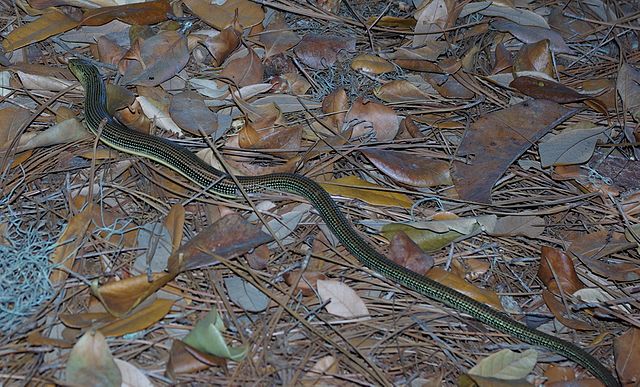
Scientific name: Ophisaurus ventralis.
Common name: Eastern glass lizard.
The Eastern glass lizard (Ophisaurus ventralis) is a slender and legless lizard, which looks very much like a snake.
They can grow up to forty three inches (108cm), they are the heaviest and longest of the glass lizards you will find in South Carolina.
They are yellow to light brown in color, sometimes even a green color with white vertical bars, which are located just behind the head. As they age, they tend to lose any patterns, taking on more green coloration.

You are likely to come across an Eastern glass lizard when in sandy areas. They can also be seen in wetlands, flat woods, and sandy areas. They are found in coastal dunes and under debris.
These lizards are most active during the day, where they hide under debris.
They will beak their tails, which continue to wriggle, enabling them to escape predators.
15. Slender Glass Lizard

Scientific name: Ophisaurus attenuatus.
Common name: Slender glass lizard.
Slender glass lizards (Ophisaurus attenuatus) are often confused with snakes, growing up to forty two inches (107cm) in length.
They are slender and legless lizards with movable eyelids, inflexible jaws, and external ear openings, which is the only way to tell them apart from snakes.
They are slimmer than the other glass lizards, taking on a brown or yellow coloration. They have dark markings, which can be found below the lateral groove. These markings fade as they age.
Many of them also have a dark stripe down their backs, which they keep as they age.
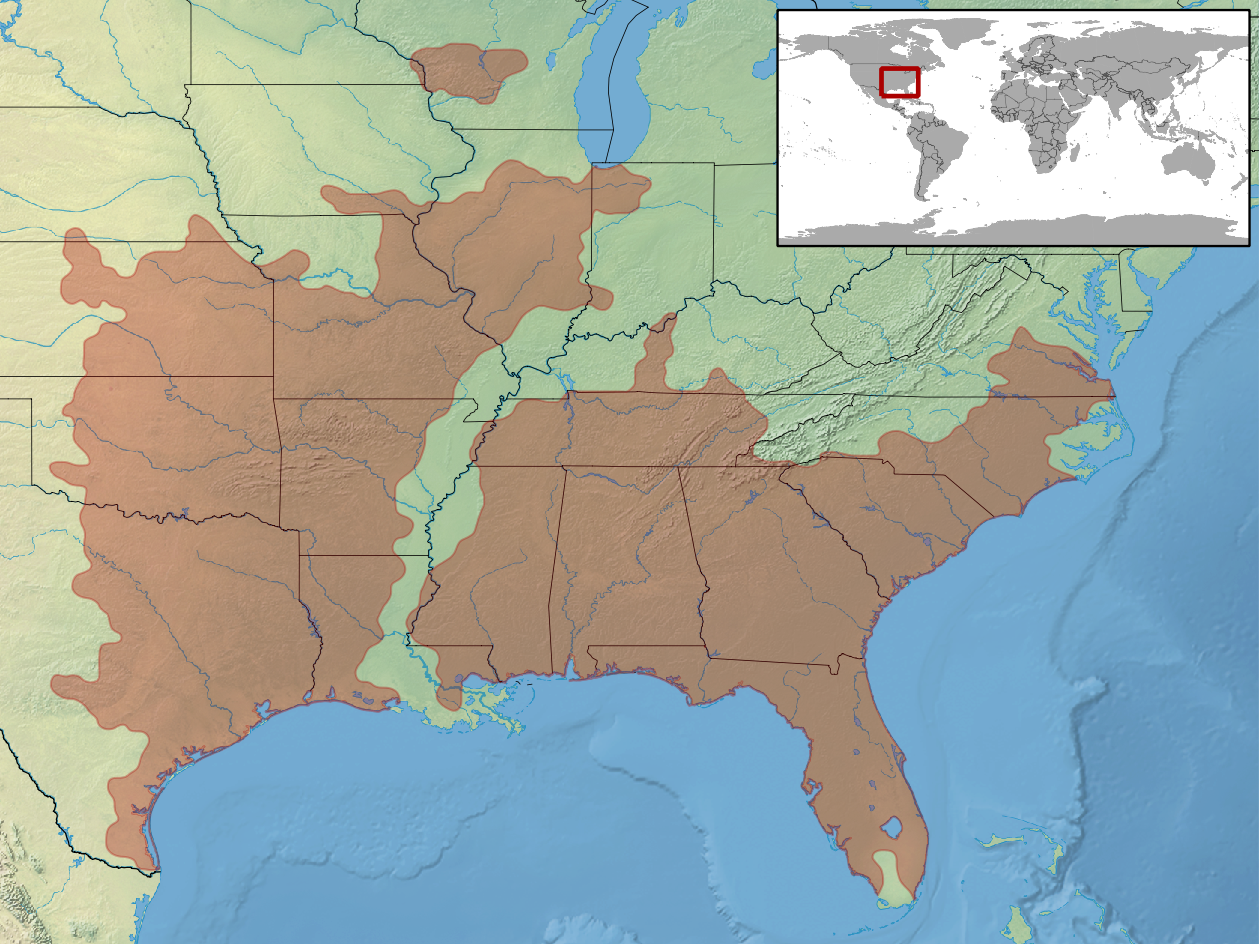
These lizards can be found in the sandy areas in South Carolina, where they prefer dry habitats, often moving into sandy areas and old fields.
They are active in the daytime, where they can be seen in open habitats as they actively hunt for food.
These glass lizards will also break off part of their tail to escape any predators.
16. Mimic Glass Lizard

Scientific name: Ophisaurus Mimicus.
Common name: Mimic glass lizard, rainbow glass lizard.
This glass lizard (Ophisaurus Mimicus) is yellow to brown in color, growing up to 26 inches (66cm) in length.
They are smaller than the slender and common glass lizards.
What identifies them from the other glass lizards in South Carolina is the dark stripes, which can be seen on either side of the body, just above the lateral groove. They also have one dark dorsal stripe.

They are active during daytime hours and will be found under debris.
If they are approached, they will try and escape, but if captured, they will break off a piece of their tail, which continues wriggling, in order to distract any predators, allowing the lizard to escape.
17. Island Glass Lizard

Scientific name: Ophisaurus Compressus.
Common name: Island glass lizard.
Island glass lizards (Ophisaurus Compressus) are slender, long, and legless lizards, often confused with snakes. They grow up to twenty four inches (61cm) in length.
Unlike snakes, they have external ear openings, inflexible jaws, and movable eyelids. These lizards are yellow to brown in color with a single dark stripe, on either side of the body, along with a dark dorsal stripe.

They are common along the South Carolina coast. They prefer dry habitats, often found in sandy areas.
It’s not uncommon to come across an island glass lizard during the day as it hunts for food. They will run and hide under debris if approached or feel threatened. They tend to also be very active in the early evening.
If captured, the lizard will break off part of its tails in order to district any predators. The tail does re-grow over time.
Further Reading:
Hello I was wondering why the lizard iguana’s wasn’t listed I own one blue iguanas which lives up to 60 years. Like wow !! Can u imagine lol an tbe green iguanas an they live long time to over 20 years I have them 5 1/2 years now I adore love them so much. There great pets but requires alit of heat mostiure year round up to 90 degrees. Thank u fir putting that video on was really look. Thane care !!